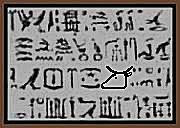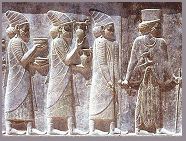
Can We Compare the Hebrew Letters
To Our English Alphabet?
|

Whenever someone begins investigating the ancient roots of the Hebrew
language, the first question which usually comes up is;
"Just how
foreign is Hebrew if it's put alongside our English?"
A small amount of research reveals it is not nearly as
foreign or unrelated as one might expect. This is the
perfect spot however to introduce you to 'Rule #1'.
 This one is easy but it takes some getting used to. A
little later we'll tell you more about who is responsible for
the reversal - but the original alphabets read from right to left.
To this day, both Hebrew and Arabic read from right to left.
Remember the "wrong side of the road"? If you pick
up a copy of the Torah (Hebrew Bible) you'll get tested
on that as the Torah opens from what we call the back of the book -
however it is not the back.
But even though it reads right to left, there are still
plenty of sounds
with which you're quite familiar.
This one is easy but it takes some getting used to. A
little later we'll tell you more about who is responsible for
the reversal - but the original alphabets read from right to left.
To this day, both Hebrew and Arabic read from right to left.
Remember the "wrong side of the road"? If you pick
up a copy of the Torah (Hebrew Bible) you'll get tested
on that as the Torah opens from what we call the back of the book -
however it is not the back.
But even though it reads right to left, there are still
plenty of sounds
with which you're quite familiar.
If we journey back
in time it is immediately evident that the individual language of
nearly every ancient culture anywhere near the Mediterranean Sea
can be traced back to the exact same foundation. While those
areas we generalize as Oriental or perhaps Far-East may represent
a separate explosion of human development, those languages
such as Hebrew, Greek, Latin and yes, eventually even our own
 English are all branches of the very same tree. The roots of
this tree actually existed right around the same time period
of the Biblical Tower of Babel story telling of languages
going off in a number of directions - which indeed they did.
The many branches of this tree are easily seen by investigating the progression
of each individual alphabet or language - but to keep this brief and entertaining
for now we'll explore the first two letters of our own alphabet,
A and B. This is especially appropriate
when you consider the word 'alpha-bet ' itself literally means
A-B. A quick glance at the comparison below demonstrates
the similarity between the original Hebrew and the English letters
normally associated with them. This will also start getting you used
to the right-to-left concept as you can easily
see the aleph and beyt similarity.
If you are curious, exploring the other letters is easy to do using
dozens of books and references, but our purpose here is to merely
demonstrate you have a lot more in common with Biblical Hebrew than
you probably assumed. Examining the origins of these letters
as well as our numbers gives us an astounding perspective on the past -
our roots.
English are all branches of the very same tree. The roots of
this tree actually existed right around the same time period
of the Biblical Tower of Babel story telling of languages
going off in a number of directions - which indeed they did.
The many branches of this tree are easily seen by investigating the progression
of each individual alphabet or language - but to keep this brief and entertaining
for now we'll explore the first two letters of our own alphabet,
A and B. This is especially appropriate
when you consider the word 'alpha-bet ' itself literally means
A-B. A quick glance at the comparison below demonstrates
the similarity between the original Hebrew and the English letters
normally associated with them. This will also start getting you used
to the right-to-left concept as you can easily
see the aleph and beyt similarity.
If you are curious, exploring the other letters is easy to do using
dozens of books and references, but our purpose here is to merely
demonstrate you have a lot more in common with Biblical Hebrew than
you probably assumed. Examining the origins of these letters
as well as our numbers gives us an astounding perspective on the past -
our roots.

A VERY Important Difference:
Originally, all written language was composed of small
recognizable drawings known as cuneiforms or hieroglyphs. You have probably
seen ancient Egyptian hieroglyphs which are wonderful and enduring examples
of that early style of written communication - done by simply 'drawing a picture'.
What must be distinguished nevertheless
is the fundamental difference between these elaborate drawings
and the far more progressive method of using a "sound" alphabet.
It's a very important distinction. Now notice,
with the original hieroglyphic inscriptions
each and every character drawn stood for an entire word. Thus, using this
method to write a sentence made up of five 'words' or concepts required only five
figures or characters. For a single word, if you use 'sound' symbols the word
"cow" requires three letter symbols (C-O-W). However the hieroglyphic
(Egyptian?) 'word' for a 'cow' ? - was simply:

 While it's easy to see this 'symbol-for-word' method may seem to greatly simplify
writing, it doesn't take much imagination to see how inefficient
and difficult that concept would quickly become. Imagine
your dictionary with every single individual word requiring a
different little drawing. With today's English
you could spend your entire life learning to write, and
even then it would be extremely laborious to use that form of writing to
explain how someone from California says "you all" but
someone from Texas says, "y'all". Consider also; if
we gave you a brand new word, with a sound alphabet you could take a stab at
spelling or writing it. If you saw the word written down, you could
even attempt to pronounce it. With cuneiform or hieroglyphic picture writing
we wouldn't have the slightest idea. Anything new would be
a complete mystery.
While it's easy to see this 'symbol-for-word' method may seem to greatly simplify
writing, it doesn't take much imagination to see how inefficient
and difficult that concept would quickly become. Imagine
your dictionary with every single individual word requiring a
different little drawing. With today's English
you could spend your entire life learning to write, and
even then it would be extremely laborious to use that form of writing to
explain how someone from California says "you all" but
someone from Texas says, "y'all". Consider also; if
we gave you a brand new word, with a sound alphabet you could take a stab at
spelling or writing it. If you saw the word written down, you could
even attempt to pronounce it. With cuneiform or hieroglyphic picture writing
we wouldn't have the slightest idea. Anything new would be
a complete mystery.
 So - who came up with the brilliant idea of these written symbols representing
a sound - instead of an entire word? It is there
we will find the first roots we now seek and our first doorway
is revealed. History books reveal
it was the ancient Phoenicians though this is our first encounter with
Greek influence. To be historically accurate these people were
actually the "Canaanites" of Canaan. The name "Phoenicians"
was bestowed on them by the Greeks, and since a lot of the documentation from that
period was Greek - Phoenicians they became. But regardless of what
we call them, theirs was the very first 'sound' alphabet. They
were responsible for instigating this major change
of using a sound symbol as the newer more flexible
'alphabet' method of writing. Within written language, this
gigantic step was - in concept - the equal of the invention of the wheel
- and nearly every alphabet which followed came from it.
So - who came up with the brilliant idea of these written symbols representing
a sound - instead of an entire word? It is there
we will find the first roots we now seek and our first doorway
is revealed. History books reveal
it was the ancient Phoenicians though this is our first encounter with
Greek influence. To be historically accurate these people were
actually the "Canaanites" of Canaan. The name "Phoenicians"
was bestowed on them by the Greeks, and since a lot of the documentation from that
period was Greek - Phoenicians they became. But regardless of what
we call them, theirs was the very first 'sound' alphabet. They
were responsible for instigating this major change
of using a sound symbol as the newer more flexible
'alphabet' method of writing. Within written language, this
gigantic step was - in concept - the equal of the invention of the wheel
- and nearly every alphabet which followed came from it.
 Being the superb ship builders and traders they were as well, the "Phoenician" influence
spread throughout that area quickly. But also, as with anyone who
explores and accepts multiple cultures, they combined their newly gathered knowledge to become
extremely brilliant with new ideas and inventions. Just one more
example; they were the first to develop a
purple dye for
clothing - created from a very special Canaan snail. Their
skill as cunning salesmen was also historically evident, as this new dye was
then traded at extremely high prices. Imagine what would happen, if
you could today create such a beautiful color - one that no one had
ever seen before. The exorbitant cost of this new
purple dye
designated it for the rich only and to this day the color
purple
is associated with royalty and wealth.
Being the superb ship builders and traders they were as well, the "Phoenician" influence
spread throughout that area quickly. But also, as with anyone who
explores and accepts multiple cultures, they combined their newly gathered knowledge to become
extremely brilliant with new ideas and inventions. Just one more
example; they were the first to develop a
purple dye for
clothing - created from a very special Canaan snail. Their
skill as cunning salesmen was also historically evident, as this new dye was
then traded at extremely high prices. Imagine what would happen, if
you could today create such a beautiful color - one that no one had
ever seen before. The exorbitant cost of this new
purple dye
designated it for the rich only and to this day the color
purple
is associated with royalty and wealth.


Holy Cow !
(also known as the letter 'A'
 ) )
|
|